Business Strategy Report: Uber's Internal & Competitive Analysis
VerifiedAdded on 2022/12/26
|15
|4752
|55
Report
AI Summary
This report provides a comprehensive analysis of Uber's business strategy, examining its macro environment through PESTEL analysis, internal capabilities using the VRIO model, and competitive forces via Porter's Five Forces. The report delves into how Uber navigates political, economic, social, technological, environmental, and legal factors, assessing their impact on the company's operations. It evaluates Uber's internal strengths and weaknesses, particularly focusing on valuable, rare, inimitable, and organized resources. Furthermore, it implements Porter's Five Forces to analyze competitive dynamics within the ride-sharing and delivery industries. The report concludes by interpreting strategic planning through various theories, concepts, and models, offering insights into Uber's approach to maintaining a competitive edge and achieving its business objectives.
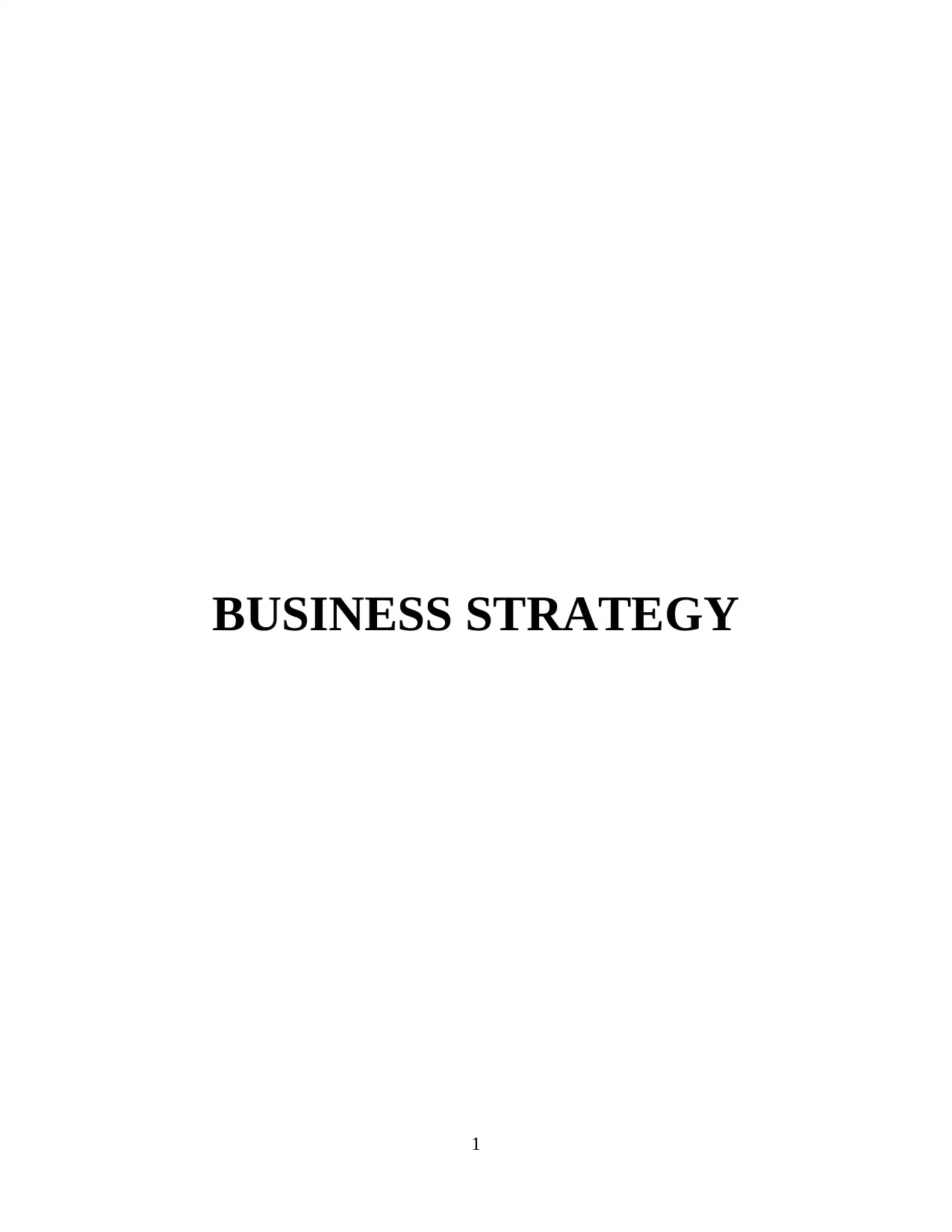
BUSINESS STRATEGY
1
1
Paraphrase This Document
Need a fresh take? Get an instant paraphrase of this document with our AI Paraphraser
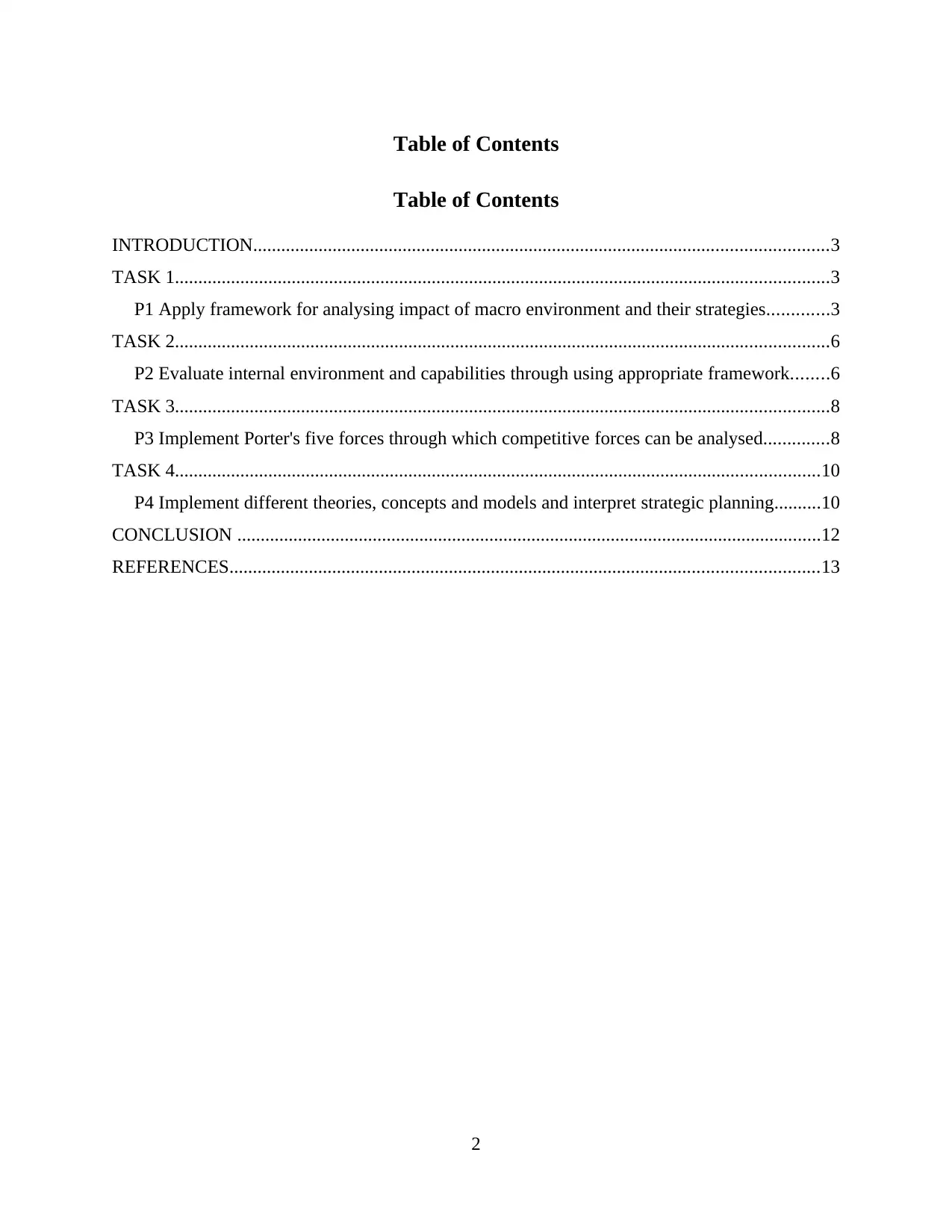
Table of Contents
Table of Contents
INTRODUCTION...........................................................................................................................3
TASK 1............................................................................................................................................3
P1 Apply framework for analysing impact of macro environment and their strategies.............3
TASK 2............................................................................................................................................6
P2 Evaluate internal environment and capabilities through using appropriate framework........6
TASK 3............................................................................................................................................8
P3 Implement Porter's five forces through which competitive forces can be analysed..............8
TASK 4..........................................................................................................................................10
P4 Implement different theories, concepts and models and interpret strategic planning..........10
CONCLUSION .............................................................................................................................12
REFERENCES..............................................................................................................................13
2
Table of Contents
INTRODUCTION...........................................................................................................................3
TASK 1............................................................................................................................................3
P1 Apply framework for analysing impact of macro environment and their strategies.............3
TASK 2............................................................................................................................................6
P2 Evaluate internal environment and capabilities through using appropriate framework........6
TASK 3............................................................................................................................................8
P3 Implement Porter's five forces through which competitive forces can be analysed..............8
TASK 4..........................................................................................................................................10
P4 Implement different theories, concepts and models and interpret strategic planning..........10
CONCLUSION .............................................................................................................................12
REFERENCES..............................................................................................................................13
2
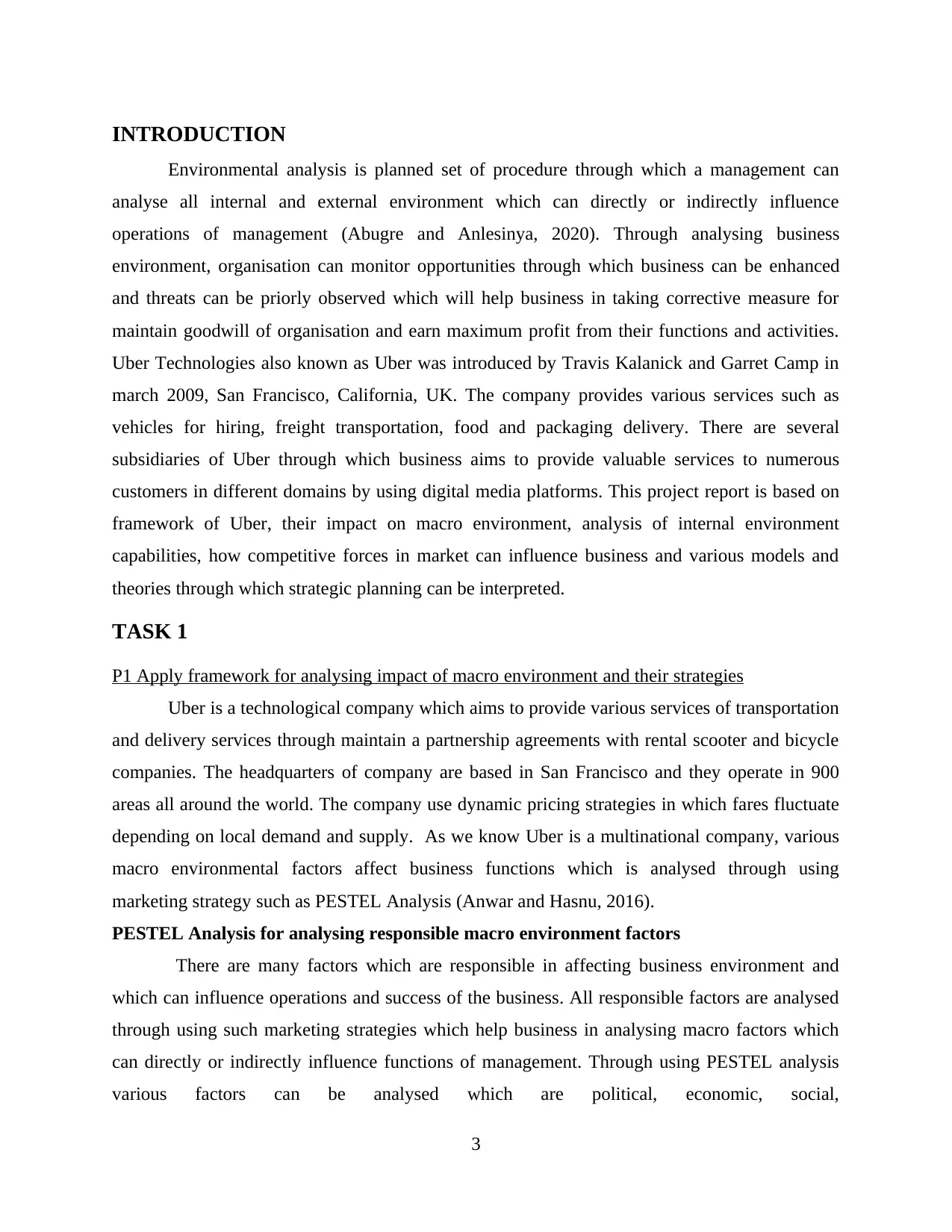
INTRODUCTION
Environmental analysis is planned set of procedure through which a management can
analyse all internal and external environment which can directly or indirectly influence
operations of management (Abugre and Anlesinya, 2020). Through analysing business
environment, organisation can monitor opportunities through which business can be enhanced
and threats can be priorly observed which will help business in taking corrective measure for
maintain goodwill of organisation and earn maximum profit from their functions and activities.
Uber Technologies also known as Uber was introduced by Travis Kalanick and Garret Camp in
march 2009, San Francisco, California, UK. The company provides various services such as
vehicles for hiring, freight transportation, food and packaging delivery. There are several
subsidiaries of Uber through which business aims to provide valuable services to numerous
customers in different domains by using digital media platforms. This project report is based on
framework of Uber, their impact on macro environment, analysis of internal environment
capabilities, how competitive forces in market can influence business and various models and
theories through which strategic planning can be interpreted.
TASK 1
P1 Apply framework for analysing impact of macro environment and their strategies
Uber is a technological company which aims to provide various services of transportation
and delivery services through maintain a partnership agreements with rental scooter and bicycle
companies. The headquarters of company are based in San Francisco and they operate in 900
areas all around the world. The company use dynamic pricing strategies in which fares fluctuate
depending on local demand and supply. As we know Uber is a multinational company, various
macro environmental factors affect business functions which is analysed through using
marketing strategy such as PESTEL Analysis (Anwar and Hasnu, 2016).
PESTEL Analysis for analysing responsible macro environment factors
There are many factors which are responsible in affecting business environment and
which can influence operations and success of the business. All responsible factors are analysed
through using such marketing strategies which help business in analysing macro factors which
can directly or indirectly influence functions of management. Through using PESTEL analysis
various factors can be analysed which are political, economic, social,
3
Environmental analysis is planned set of procedure through which a management can
analyse all internal and external environment which can directly or indirectly influence
operations of management (Abugre and Anlesinya, 2020). Through analysing business
environment, organisation can monitor opportunities through which business can be enhanced
and threats can be priorly observed which will help business in taking corrective measure for
maintain goodwill of organisation and earn maximum profit from their functions and activities.
Uber Technologies also known as Uber was introduced by Travis Kalanick and Garret Camp in
march 2009, San Francisco, California, UK. The company provides various services such as
vehicles for hiring, freight transportation, food and packaging delivery. There are several
subsidiaries of Uber through which business aims to provide valuable services to numerous
customers in different domains by using digital media platforms. This project report is based on
framework of Uber, their impact on macro environment, analysis of internal environment
capabilities, how competitive forces in market can influence business and various models and
theories through which strategic planning can be interpreted.
TASK 1
P1 Apply framework for analysing impact of macro environment and their strategies
Uber is a technological company which aims to provide various services of transportation
and delivery services through maintain a partnership agreements with rental scooter and bicycle
companies. The headquarters of company are based in San Francisco and they operate in 900
areas all around the world. The company use dynamic pricing strategies in which fares fluctuate
depending on local demand and supply. As we know Uber is a multinational company, various
macro environmental factors affect business functions which is analysed through using
marketing strategy such as PESTEL Analysis (Anwar and Hasnu, 2016).
PESTEL Analysis for analysing responsible macro environment factors
There are many factors which are responsible in affecting business environment and
which can influence operations and success of the business. All responsible factors are analysed
through using such marketing strategies which help business in analysing macro factors which
can directly or indirectly influence functions of management. Through using PESTEL analysis
various factors can be analysed which are political, economic, social,
3
⊘ This is a preview!⊘
Do you want full access?
Subscribe today to unlock all pages.

Trusted by 1+ million students worldwide
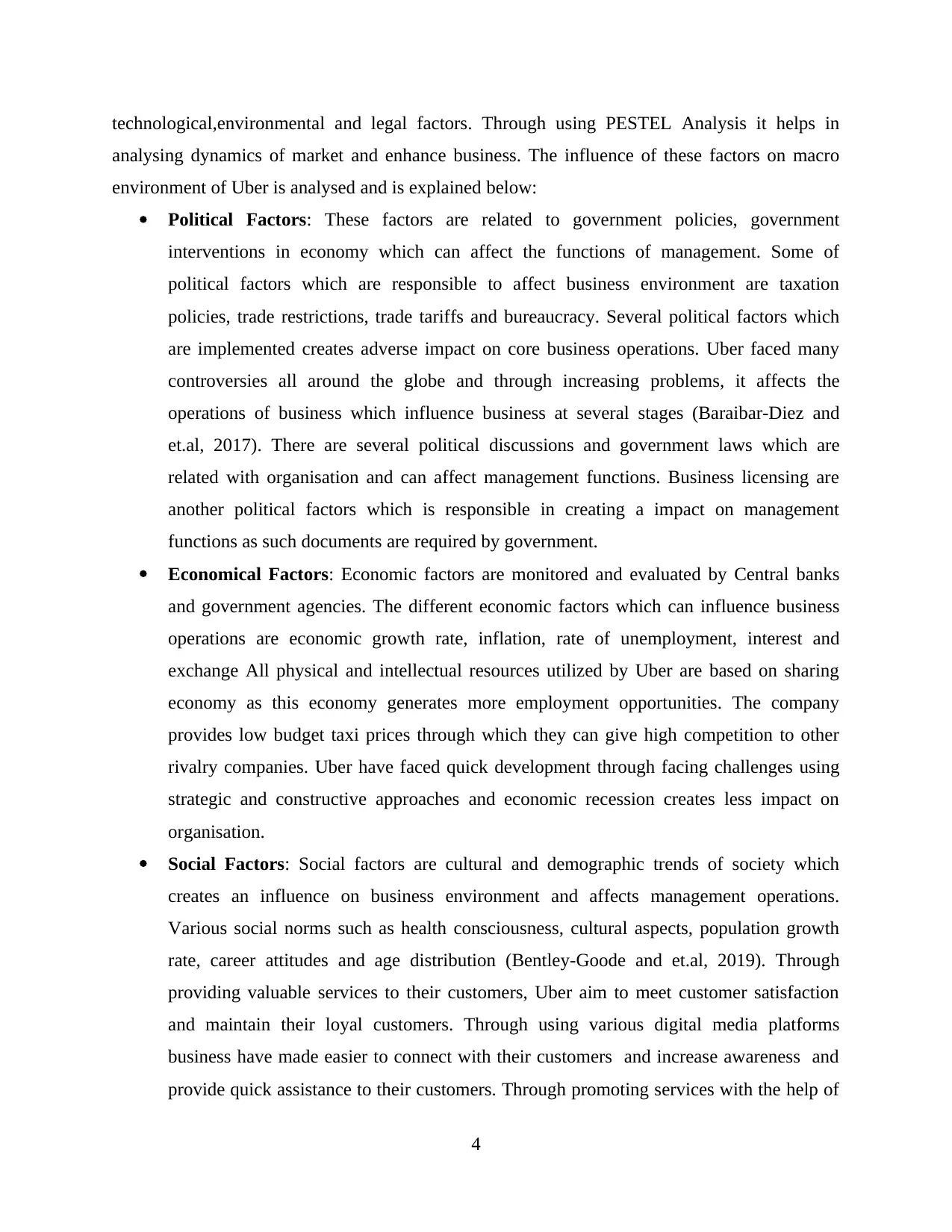
technological,environmental and legal factors. Through using PESTEL Analysis it helps in
analysing dynamics of market and enhance business. The influence of these factors on macro
environment of Uber is analysed and is explained below:
Political Factors: These factors are related to government policies, government
interventions in economy which can affect the functions of management. Some of
political factors which are responsible to affect business environment are taxation
policies, trade restrictions, trade tariffs and bureaucracy. Several political factors which
are implemented creates adverse impact on core business operations. Uber faced many
controversies all around the globe and through increasing problems, it affects the
operations of business which influence business at several stages (Baraibar‐Diez and
et.al, 2017). There are several political discussions and government laws which are
related with organisation and can affect management functions. Business licensing are
another political factors which is responsible in creating a impact on management
functions as such documents are required by government.
Economical Factors: Economic factors are monitored and evaluated by Central banks
and government agencies. The different economic factors which can influence business
operations are economic growth rate, inflation, rate of unemployment, interest and
exchange All physical and intellectual resources utilized by Uber are based on sharing
economy as this economy generates more employment opportunities. The company
provides low budget taxi prices through which they can give high competition to other
rivalry companies. Uber have faced quick development through facing challenges using
strategic and constructive approaches and economic recession creates less impact on
organisation.
Social Factors: Social factors are cultural and demographic trends of society which
creates an influence on business environment and affects management operations.
Various social norms such as health consciousness, cultural aspects, population growth
rate, career attitudes and age distribution (Bentley-Goode and et.al, 2019). Through
providing valuable services to their customers, Uber aim to meet customer satisfaction
and maintain their loyal customers. Through using various digital media platforms
business have made easier to connect with their customers and increase awareness and
provide quick assistance to their customers. Through promoting services with the help of
4
analysing dynamics of market and enhance business. The influence of these factors on macro
environment of Uber is analysed and is explained below:
Political Factors: These factors are related to government policies, government
interventions in economy which can affect the functions of management. Some of
political factors which are responsible to affect business environment are taxation
policies, trade restrictions, trade tariffs and bureaucracy. Several political factors which
are implemented creates adverse impact on core business operations. Uber faced many
controversies all around the globe and through increasing problems, it affects the
operations of business which influence business at several stages (Baraibar‐Diez and
et.al, 2017). There are several political discussions and government laws which are
related with organisation and can affect management functions. Business licensing are
another political factors which is responsible in creating a impact on management
functions as such documents are required by government.
Economical Factors: Economic factors are monitored and evaluated by Central banks
and government agencies. The different economic factors which can influence business
operations are economic growth rate, inflation, rate of unemployment, interest and
exchange All physical and intellectual resources utilized by Uber are based on sharing
economy as this economy generates more employment opportunities. The company
provides low budget taxi prices through which they can give high competition to other
rivalry companies. Uber have faced quick development through facing challenges using
strategic and constructive approaches and economic recession creates less impact on
organisation.
Social Factors: Social factors are cultural and demographic trends of society which
creates an influence on business environment and affects management operations.
Various social norms such as health consciousness, cultural aspects, population growth
rate, career attitudes and age distribution (Bentley-Goode and et.al, 2019). Through
providing valuable services to their customers, Uber aim to meet customer satisfaction
and maintain their loyal customers. Through using various digital media platforms
business have made easier to connect with their customers and increase awareness and
provide quick assistance to their customers. Through promoting services with the help of
4
Paraphrase This Document
Need a fresh take? Get an instant paraphrase of this document with our AI Paraphraser
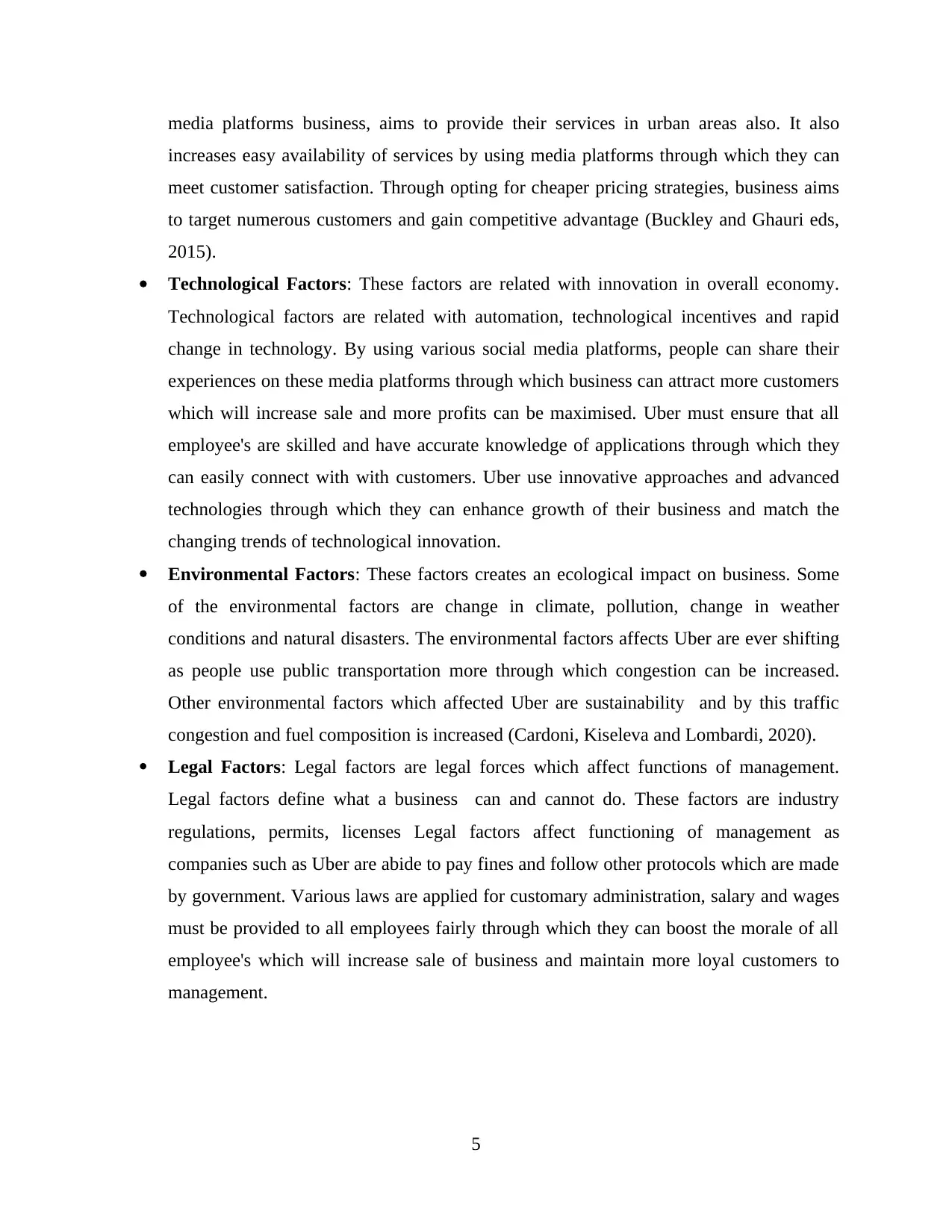
media platforms business, aims to provide their services in urban areas also. It also
increases easy availability of services by using media platforms through which they can
meet customer satisfaction. Through opting for cheaper pricing strategies, business aims
to target numerous customers and gain competitive advantage (Buckley and Ghauri eds,
2015).
Technological Factors: These factors are related with innovation in overall economy.
Technological factors are related with automation, technological incentives and rapid
change in technology. By using various social media platforms, people can share their
experiences on these media platforms through which business can attract more customers
which will increase sale and more profits can be maximised. Uber must ensure that all
employee's are skilled and have accurate knowledge of applications through which they
can easily connect with with customers. Uber use innovative approaches and advanced
technologies through which they can enhance growth of their business and match the
changing trends of technological innovation.
Environmental Factors: These factors creates an ecological impact on business. Some
of the environmental factors are change in climate, pollution, change in weather
conditions and natural disasters. The environmental factors affects Uber are ever shifting
as people use public transportation more through which congestion can be increased.
Other environmental factors which affected Uber are sustainability and by this traffic
congestion and fuel composition is increased (Cardoni, Kiseleva and Lombardi, 2020).
Legal Factors: Legal factors are legal forces which affect functions of management.
Legal factors define what a business can and cannot do. These factors are industry
regulations, permits, licenses Legal factors affect functioning of management as
companies such as Uber are abide to pay fines and follow other protocols which are made
by government. Various laws are applied for customary administration, salary and wages
must be provided to all employees fairly through which they can boost the morale of all
employee's which will increase sale of business and maintain more loyal customers to
management.
5
increases easy availability of services by using media platforms through which they can
meet customer satisfaction. Through opting for cheaper pricing strategies, business aims
to target numerous customers and gain competitive advantage (Buckley and Ghauri eds,
2015).
Technological Factors: These factors are related with innovation in overall economy.
Technological factors are related with automation, technological incentives and rapid
change in technology. By using various social media platforms, people can share their
experiences on these media platforms through which business can attract more customers
which will increase sale and more profits can be maximised. Uber must ensure that all
employee's are skilled and have accurate knowledge of applications through which they
can easily connect with with customers. Uber use innovative approaches and advanced
technologies through which they can enhance growth of their business and match the
changing trends of technological innovation.
Environmental Factors: These factors creates an ecological impact on business. Some
of the environmental factors are change in climate, pollution, change in weather
conditions and natural disasters. The environmental factors affects Uber are ever shifting
as people use public transportation more through which congestion can be increased.
Other environmental factors which affected Uber are sustainability and by this traffic
congestion and fuel composition is increased (Cardoni, Kiseleva and Lombardi, 2020).
Legal Factors: Legal factors are legal forces which affect functions of management.
Legal factors define what a business can and cannot do. These factors are industry
regulations, permits, licenses Legal factors affect functioning of management as
companies such as Uber are abide to pay fines and follow other protocols which are made
by government. Various laws are applied for customary administration, salary and wages
must be provided to all employees fairly through which they can boost the morale of all
employee's which will increase sale of business and maintain more loyal customers to
management.
5
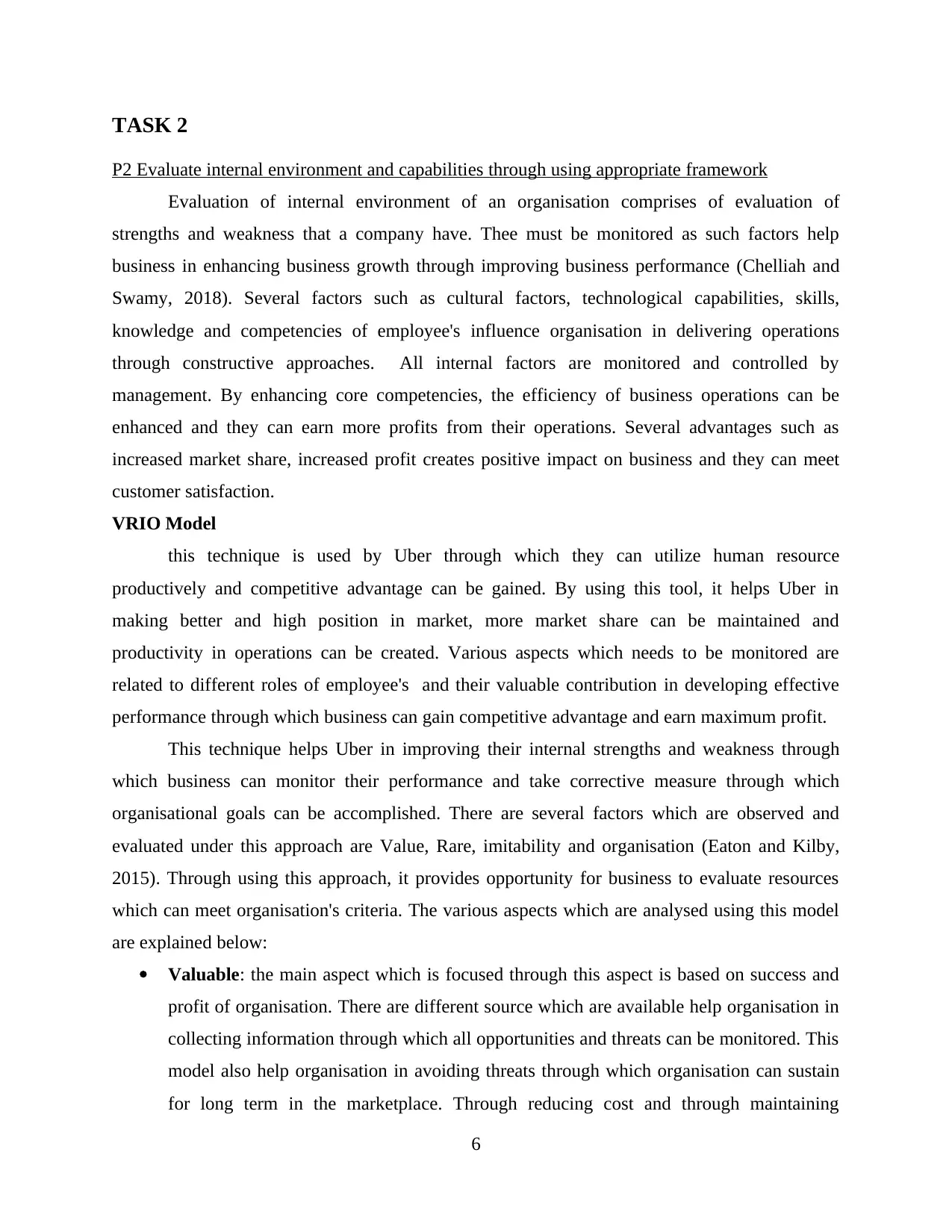
TASK 2
P2 Evaluate internal environment and capabilities through using appropriate framework
Evaluation of internal environment of an organisation comprises of evaluation of
strengths and weakness that a company have. Thee must be monitored as such factors help
business in enhancing business growth through improving business performance (Chelliah and
Swamy, 2018). Several factors such as cultural factors, technological capabilities, skills,
knowledge and competencies of employee's influence organisation in delivering operations
through constructive approaches. All internal factors are monitored and controlled by
management. By enhancing core competencies, the efficiency of business operations can be
enhanced and they can earn more profits from their operations. Several advantages such as
increased market share, increased profit creates positive impact on business and they can meet
customer satisfaction.
VRIO Model
this technique is used by Uber through which they can utilize human resource
productively and competitive advantage can be gained. By using this tool, it helps Uber in
making better and high position in market, more market share can be maintained and
productivity in operations can be created. Various aspects which needs to be monitored are
related to different roles of employee's and their valuable contribution in developing effective
performance through which business can gain competitive advantage and earn maximum profit.
This technique helps Uber in improving their internal strengths and weakness through
which business can monitor their performance and take corrective measure through which
organisational goals can be accomplished. There are several factors which are observed and
evaluated under this approach are Value, Rare, imitability and organisation (Eaton and Kilby,
2015). Through using this approach, it provides opportunity for business to evaluate resources
which can meet organisation's criteria. The various aspects which are analysed using this model
are explained below:
Valuable: the main aspect which is focused through this aspect is based on success and
profit of organisation. There are different source which are available help organisation in
collecting information through which all opportunities and threats can be monitored. This
model also help organisation in avoiding threats through which organisation can sustain
for long term in the marketplace. Through reducing cost and through maintaining
6
P2 Evaluate internal environment and capabilities through using appropriate framework
Evaluation of internal environment of an organisation comprises of evaluation of
strengths and weakness that a company have. Thee must be monitored as such factors help
business in enhancing business growth through improving business performance (Chelliah and
Swamy, 2018). Several factors such as cultural factors, technological capabilities, skills,
knowledge and competencies of employee's influence organisation in delivering operations
through constructive approaches. All internal factors are monitored and controlled by
management. By enhancing core competencies, the efficiency of business operations can be
enhanced and they can earn more profits from their operations. Several advantages such as
increased market share, increased profit creates positive impact on business and they can meet
customer satisfaction.
VRIO Model
this technique is used by Uber through which they can utilize human resource
productively and competitive advantage can be gained. By using this tool, it helps Uber in
making better and high position in market, more market share can be maintained and
productivity in operations can be created. Various aspects which needs to be monitored are
related to different roles of employee's and their valuable contribution in developing effective
performance through which business can gain competitive advantage and earn maximum profit.
This technique helps Uber in improving their internal strengths and weakness through
which business can monitor their performance and take corrective measure through which
organisational goals can be accomplished. There are several factors which are observed and
evaluated under this approach are Value, Rare, imitability and organisation (Eaton and Kilby,
2015). Through using this approach, it provides opportunity for business to evaluate resources
which can meet organisation's criteria. The various aspects which are analysed using this model
are explained below:
Valuable: the main aspect which is focused through this aspect is based on success and
profit of organisation. There are different source which are available help organisation in
collecting information through which all opportunities and threats can be monitored. This
model also help organisation in avoiding threats through which organisation can sustain
for long term in the marketplace. Through reducing cost and through maintaining
6
⊘ This is a preview!⊘
Do you want full access?
Subscribe today to unlock all pages.

Trusted by 1+ million students worldwide
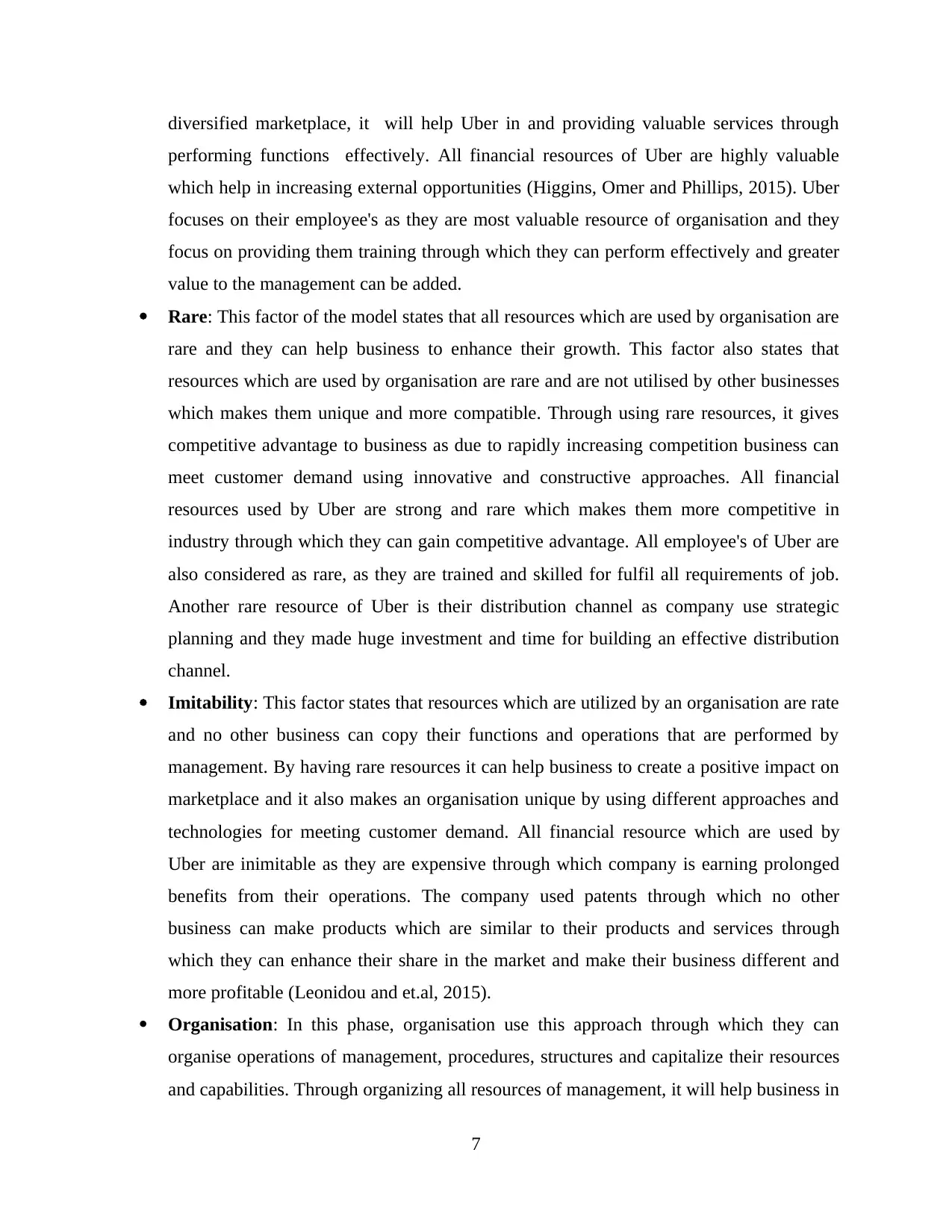
diversified marketplace, it will help Uber in and providing valuable services through
performing functions effectively. All financial resources of Uber are highly valuable
which help in increasing external opportunities (Higgins, Omer and Phillips, 2015). Uber
focuses on their employee's as they are most valuable resource of organisation and they
focus on providing them training through which they can perform effectively and greater
value to the management can be added.
Rare: This factor of the model states that all resources which are used by organisation are
rare and they can help business to enhance their growth. This factor also states that
resources which are used by organisation are rare and are not utilised by other businesses
which makes them unique and more compatible. Through using rare resources, it gives
competitive advantage to business as due to rapidly increasing competition business can
meet customer demand using innovative and constructive approaches. All financial
resources used by Uber are strong and rare which makes them more competitive in
industry through which they can gain competitive advantage. All employee's of Uber are
also considered as rare, as they are trained and skilled for fulfil all requirements of job.
Another rare resource of Uber is their distribution channel as company use strategic
planning and they made huge investment and time for building an effective distribution
channel.
Imitability: This factor states that resources which are utilized by an organisation are rate
and no other business can copy their functions and operations that are performed by
management. By having rare resources it can help business to create a positive impact on
marketplace and it also makes an organisation unique by using different approaches and
technologies for meeting customer demand. All financial resource which are used by
Uber are inimitable as they are expensive through which company is earning prolonged
benefits from their operations. The company used patents through which no other
business can make products which are similar to their products and services through
which they can enhance their share in the market and make their business different and
more profitable (Leonidou and et.al, 2015).
Organisation: In this phase, organisation use this approach through which they can
organise operations of management, procedures, structures and capitalize their resources
and capabilities. Through organizing all resources of management, it will help business in
7
performing functions effectively. All financial resources of Uber are highly valuable
which help in increasing external opportunities (Higgins, Omer and Phillips, 2015). Uber
focuses on their employee's as they are most valuable resource of organisation and they
focus on providing them training through which they can perform effectively and greater
value to the management can be added.
Rare: This factor of the model states that all resources which are used by organisation are
rare and they can help business to enhance their growth. This factor also states that
resources which are used by organisation are rare and are not utilised by other businesses
which makes them unique and more compatible. Through using rare resources, it gives
competitive advantage to business as due to rapidly increasing competition business can
meet customer demand using innovative and constructive approaches. All financial
resources used by Uber are strong and rare which makes them more competitive in
industry through which they can gain competitive advantage. All employee's of Uber are
also considered as rare, as they are trained and skilled for fulfil all requirements of job.
Another rare resource of Uber is their distribution channel as company use strategic
planning and they made huge investment and time for building an effective distribution
channel.
Imitability: This factor states that resources which are utilized by an organisation are rate
and no other business can copy their functions and operations that are performed by
management. By having rare resources it can help business to create a positive impact on
marketplace and it also makes an organisation unique by using different approaches and
technologies for meeting customer demand. All financial resource which are used by
Uber are inimitable as they are expensive through which company is earning prolonged
benefits from their operations. The company used patents through which no other
business can make products which are similar to their products and services through
which they can enhance their share in the market and make their business different and
more profitable (Leonidou and et.al, 2015).
Organisation: In this phase, organisation use this approach through which they can
organise operations of management, procedures, structures and capitalize their resources
and capabilities. Through organizing all resources of management, it will help business in
7
Paraphrase This Document
Need a fresh take? Get an instant paraphrase of this document with our AI Paraphraser
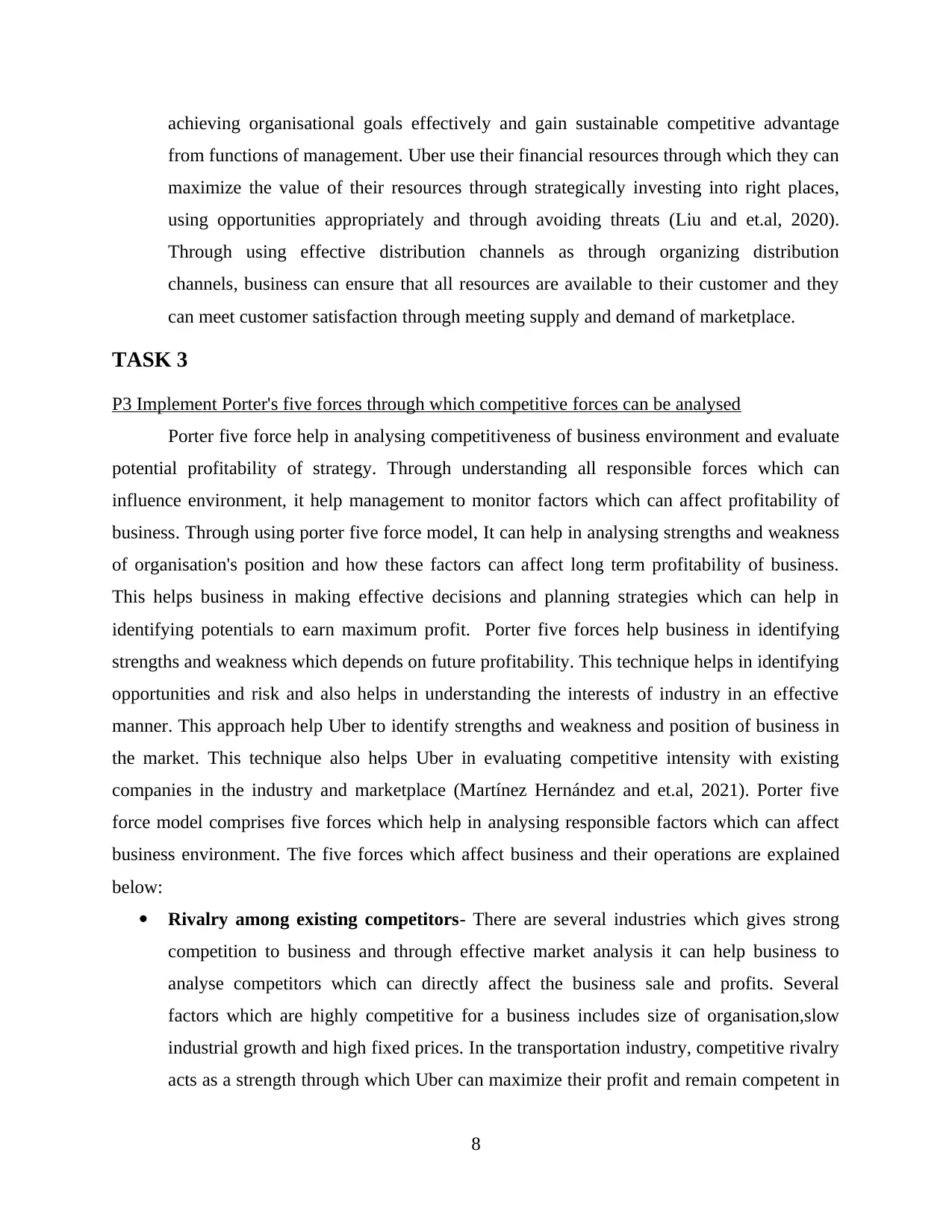
achieving organisational goals effectively and gain sustainable competitive advantage
from functions of management. Uber use their financial resources through which they can
maximize the value of their resources through strategically investing into right places,
using opportunities appropriately and through avoiding threats (Liu and et.al, 2020).
Through using effective distribution channels as through organizing distribution
channels, business can ensure that all resources are available to their customer and they
can meet customer satisfaction through meeting supply and demand of marketplace.
TASK 3
P3 Implement Porter's five forces through which competitive forces can be analysed
Porter five force help in analysing competitiveness of business environment and evaluate
potential profitability of strategy. Through understanding all responsible forces which can
influence environment, it help management to monitor factors which can affect profitability of
business. Through using porter five force model, It can help in analysing strengths and weakness
of organisation's position and how these factors can affect long term profitability of business.
This helps business in making effective decisions and planning strategies which can help in
identifying potentials to earn maximum profit. Porter five forces help business in identifying
strengths and weakness which depends on future profitability. This technique helps in identifying
opportunities and risk and also helps in understanding the interests of industry in an effective
manner. This approach help Uber to identify strengths and weakness and position of business in
the market. This technique also helps Uber in evaluating competitive intensity with existing
companies in the industry and marketplace (Martínez Hernández and et.al, 2021). Porter five
force model comprises five forces which help in analysing responsible factors which can affect
business environment. The five forces which affect business and their operations are explained
below:
Rivalry among existing competitors- There are several industries which gives strong
competition to business and through effective market analysis it can help business to
analyse competitors which can directly affect the business sale and profits. Several
factors which are highly competitive for a business includes size of organisation,slow
industrial growth and high fixed prices. In the transportation industry, competitive rivalry
acts as a strength through which Uber can maximize their profit and remain competent in
8
from functions of management. Uber use their financial resources through which they can
maximize the value of their resources through strategically investing into right places,
using opportunities appropriately and through avoiding threats (Liu and et.al, 2020).
Through using effective distribution channels as through organizing distribution
channels, business can ensure that all resources are available to their customer and they
can meet customer satisfaction through meeting supply and demand of marketplace.
TASK 3
P3 Implement Porter's five forces through which competitive forces can be analysed
Porter five force help in analysing competitiveness of business environment and evaluate
potential profitability of strategy. Through understanding all responsible forces which can
influence environment, it help management to monitor factors which can affect profitability of
business. Through using porter five force model, It can help in analysing strengths and weakness
of organisation's position and how these factors can affect long term profitability of business.
This helps business in making effective decisions and planning strategies which can help in
identifying potentials to earn maximum profit. Porter five forces help business in identifying
strengths and weakness which depends on future profitability. This technique helps in identifying
opportunities and risk and also helps in understanding the interests of industry in an effective
manner. This approach help Uber to identify strengths and weakness and position of business in
the market. This technique also helps Uber in evaluating competitive intensity with existing
companies in the industry and marketplace (Martínez Hernández and et.al, 2021). Porter five
force model comprises five forces which help in analysing responsible factors which can affect
business environment. The five forces which affect business and their operations are explained
below:
Rivalry among existing competitors- There are several industries which gives strong
competition to business and through effective market analysis it can help business to
analyse competitors which can directly affect the business sale and profits. Several
factors which are highly competitive for a business includes size of organisation,slow
industrial growth and high fixed prices. In the transportation industry, competitive rivalry
acts as a strength through which Uber can maximize their profit and remain competent in
8
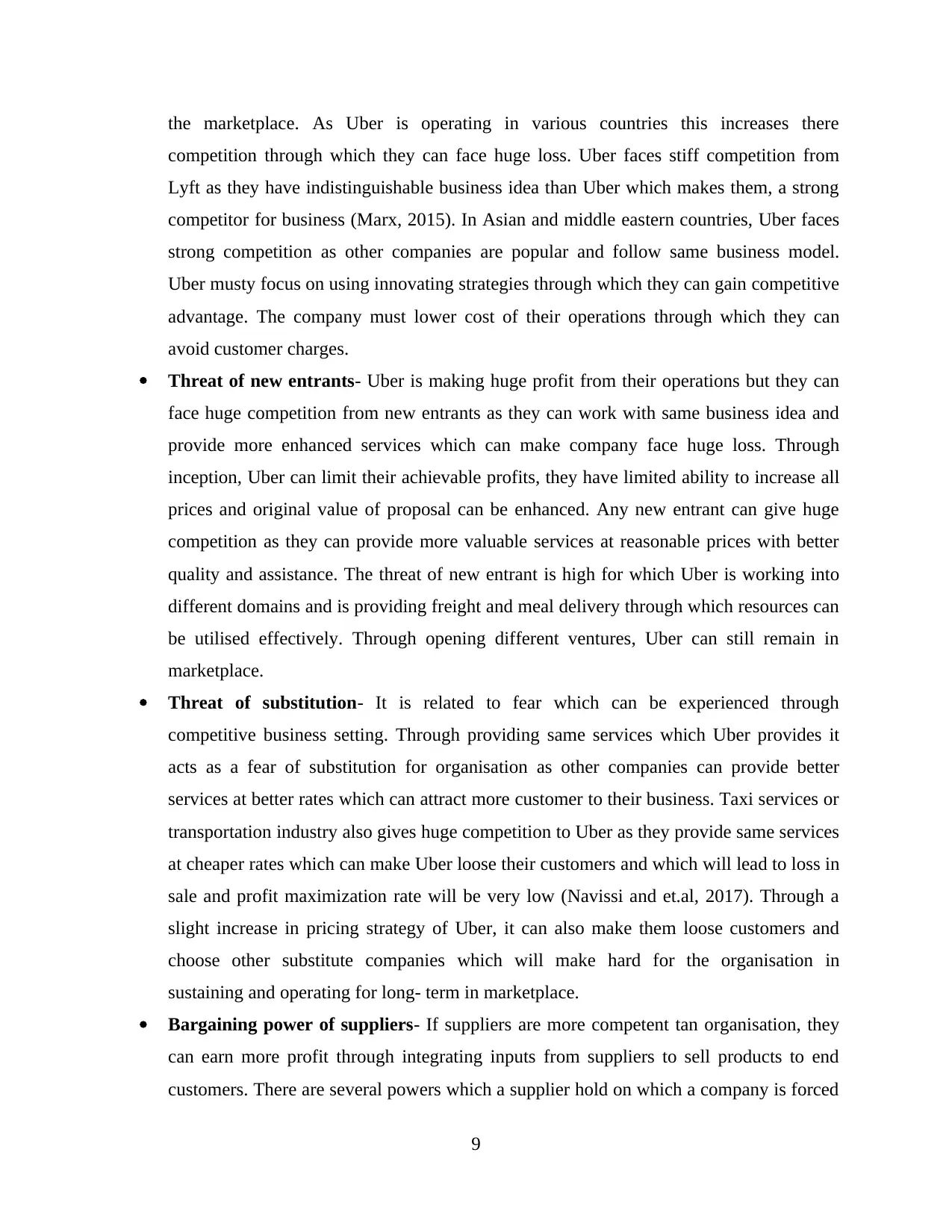
the marketplace. As Uber is operating in various countries this increases there
competition through which they can face huge loss. Uber faces stiff competition from
Lyft as they have indistinguishable business idea than Uber which makes them, a strong
competitor for business (Marx, 2015). In Asian and middle eastern countries, Uber faces
strong competition as other companies are popular and follow same business model.
Uber musty focus on using innovating strategies through which they can gain competitive
advantage. The company must lower cost of their operations through which they can
avoid customer charges.
Threat of new entrants- Uber is making huge profit from their operations but they can
face huge competition from new entrants as they can work with same business idea and
provide more enhanced services which can make company face huge loss. Through
inception, Uber can limit their achievable profits, they have limited ability to increase all
prices and original value of proposal can be enhanced. Any new entrant can give huge
competition as they can provide more valuable services at reasonable prices with better
quality and assistance. The threat of new entrant is high for which Uber is working into
different domains and is providing freight and meal delivery through which resources can
be utilised effectively. Through opening different ventures, Uber can still remain in
marketplace.
Threat of substitution- It is related to fear which can be experienced through
competitive business setting. Through providing same services which Uber provides it
acts as a fear of substitution for organisation as other companies can provide better
services at better rates which can attract more customer to their business. Taxi services or
transportation industry also gives huge competition to Uber as they provide same services
at cheaper rates which can make Uber loose their customers and which will lead to loss in
sale and profit maximization rate will be very low (Navissi and et.al, 2017). Through a
slight increase in pricing strategy of Uber, it can also make them loose customers and
choose other substitute companies which will make hard for the organisation in
sustaining and operating for long- term in marketplace.
Bargaining power of suppliers- If suppliers are more competent tan organisation, they
can earn more profit through integrating inputs from suppliers to sell products to end
customers. There are several powers which a supplier hold on which a company is forced
9
competition through which they can face huge loss. Uber faces stiff competition from
Lyft as they have indistinguishable business idea than Uber which makes them, a strong
competitor for business (Marx, 2015). In Asian and middle eastern countries, Uber faces
strong competition as other companies are popular and follow same business model.
Uber musty focus on using innovating strategies through which they can gain competitive
advantage. The company must lower cost of their operations through which they can
avoid customer charges.
Threat of new entrants- Uber is making huge profit from their operations but they can
face huge competition from new entrants as they can work with same business idea and
provide more enhanced services which can make company face huge loss. Through
inception, Uber can limit their achievable profits, they have limited ability to increase all
prices and original value of proposal can be enhanced. Any new entrant can give huge
competition as they can provide more valuable services at reasonable prices with better
quality and assistance. The threat of new entrant is high for which Uber is working into
different domains and is providing freight and meal delivery through which resources can
be utilised effectively. Through opening different ventures, Uber can still remain in
marketplace.
Threat of substitution- It is related to fear which can be experienced through
competitive business setting. Through providing same services which Uber provides it
acts as a fear of substitution for organisation as other companies can provide better
services at better rates which can attract more customer to their business. Taxi services or
transportation industry also gives huge competition to Uber as they provide same services
at cheaper rates which can make Uber loose their customers and which will lead to loss in
sale and profit maximization rate will be very low (Navissi and et.al, 2017). Through a
slight increase in pricing strategy of Uber, it can also make them loose customers and
choose other substitute companies which will make hard for the organisation in
sustaining and operating for long- term in marketplace.
Bargaining power of suppliers- If suppliers are more competent tan organisation, they
can earn more profit through integrating inputs from suppliers to sell products to end
customers. There are several powers which a supplier hold on which a company is forced
9
⊘ This is a preview!⊘
Do you want full access?
Subscribe today to unlock all pages.

Trusted by 1+ million students worldwide
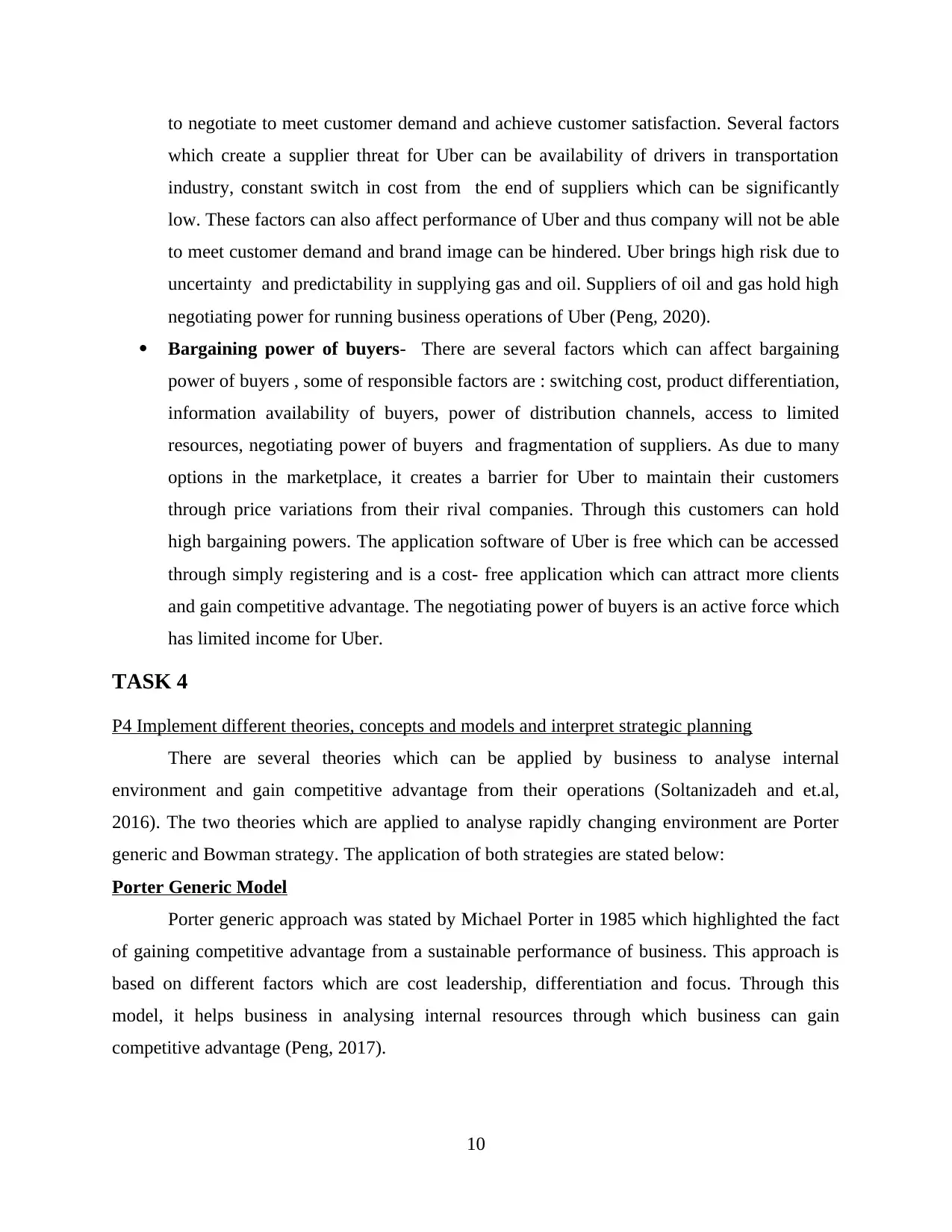
to negotiate to meet customer demand and achieve customer satisfaction. Several factors
which create a supplier threat for Uber can be availability of drivers in transportation
industry, constant switch in cost from the end of suppliers which can be significantly
low. These factors can also affect performance of Uber and thus company will not be able
to meet customer demand and brand image can be hindered. Uber brings high risk due to
uncertainty and predictability in supplying gas and oil. Suppliers of oil and gas hold high
negotiating power for running business operations of Uber (Peng, 2020).
Bargaining power of buyers- There are several factors which can affect bargaining
power of buyers , some of responsible factors are : switching cost, product differentiation,
information availability of buyers, power of distribution channels, access to limited
resources, negotiating power of buyers and fragmentation of suppliers. As due to many
options in the marketplace, it creates a barrier for Uber to maintain their customers
through price variations from their rival companies. Through this customers can hold
high bargaining powers. The application software of Uber is free which can be accessed
through simply registering and is a cost- free application which can attract more clients
and gain competitive advantage. The negotiating power of buyers is an active force which
has limited income for Uber.
TASK 4
P4 Implement different theories, concepts and models and interpret strategic planning
There are several theories which can be applied by business to analyse internal
environment and gain competitive advantage from their operations (Soltanizadeh and et.al,
2016). The two theories which are applied to analyse rapidly changing environment are Porter
generic and Bowman strategy. The application of both strategies are stated below:
Porter Generic Model
Porter generic approach was stated by Michael Porter in 1985 which highlighted the fact
of gaining competitive advantage from a sustainable performance of business. This approach is
based on different factors which are cost leadership, differentiation and focus. Through this
model, it helps business in analysing internal resources through which business can gain
competitive advantage (Peng, 2017).
10
which create a supplier threat for Uber can be availability of drivers in transportation
industry, constant switch in cost from the end of suppliers which can be significantly
low. These factors can also affect performance of Uber and thus company will not be able
to meet customer demand and brand image can be hindered. Uber brings high risk due to
uncertainty and predictability in supplying gas and oil. Suppliers of oil and gas hold high
negotiating power for running business operations of Uber (Peng, 2020).
Bargaining power of buyers- There are several factors which can affect bargaining
power of buyers , some of responsible factors are : switching cost, product differentiation,
information availability of buyers, power of distribution channels, access to limited
resources, negotiating power of buyers and fragmentation of suppliers. As due to many
options in the marketplace, it creates a barrier for Uber to maintain their customers
through price variations from their rival companies. Through this customers can hold
high bargaining powers. The application software of Uber is free which can be accessed
through simply registering and is a cost- free application which can attract more clients
and gain competitive advantage. The negotiating power of buyers is an active force which
has limited income for Uber.
TASK 4
P4 Implement different theories, concepts and models and interpret strategic planning
There are several theories which can be applied by business to analyse internal
environment and gain competitive advantage from their operations (Soltanizadeh and et.al,
2016). The two theories which are applied to analyse rapidly changing environment are Porter
generic and Bowman strategy. The application of both strategies are stated below:
Porter Generic Model
Porter generic approach was stated by Michael Porter in 1985 which highlighted the fact
of gaining competitive advantage from a sustainable performance of business. This approach is
based on different factors which are cost leadership, differentiation and focus. Through this
model, it helps business in analysing internal resources through which business can gain
competitive advantage (Peng, 2017).
10
Paraphrase This Document
Need a fresh take? Get an instant paraphrase of this document with our AI Paraphraser
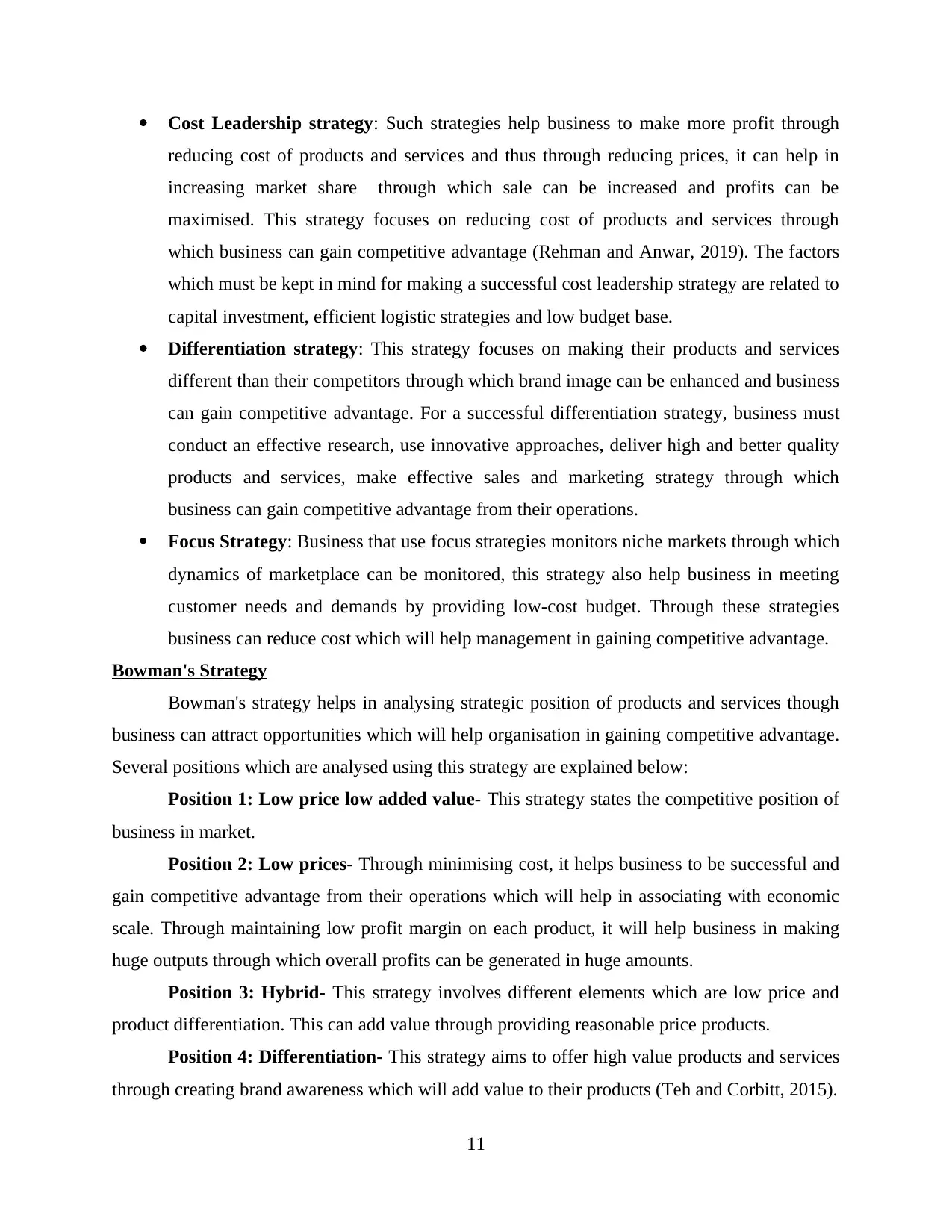
Cost Leadership strategy: Such strategies help business to make more profit through
reducing cost of products and services and thus through reducing prices, it can help in
increasing market share through which sale can be increased and profits can be
maximised. This strategy focuses on reducing cost of products and services through
which business can gain competitive advantage (Rehman and Anwar, 2019). The factors
which must be kept in mind for making a successful cost leadership strategy are related to
capital investment, efficient logistic strategies and low budget base.
Differentiation strategy: This strategy focuses on making their products and services
different than their competitors through which brand image can be enhanced and business
can gain competitive advantage. For a successful differentiation strategy, business must
conduct an effective research, use innovative approaches, deliver high and better quality
products and services, make effective sales and marketing strategy through which
business can gain competitive advantage from their operations.
Focus Strategy: Business that use focus strategies monitors niche markets through which
dynamics of marketplace can be monitored, this strategy also help business in meeting
customer needs and demands by providing low-cost budget. Through these strategies
business can reduce cost which will help management in gaining competitive advantage.
Bowman's Strategy
Bowman's strategy helps in analysing strategic position of products and services though
business can attract opportunities which will help organisation in gaining competitive advantage.
Several positions which are analysed using this strategy are explained below:
Position 1: Low price low added value- This strategy states the competitive position of
business in market.
Position 2: Low prices- Through minimising cost, it helps business to be successful and
gain competitive advantage from their operations which will help in associating with economic
scale. Through maintaining low profit margin on each product, it will help business in making
huge outputs through which overall profits can be generated in huge amounts.
Position 3: Hybrid- This strategy involves different elements which are low price and
product differentiation. This can add value through providing reasonable price products.
Position 4: Differentiation- This strategy aims to offer high value products and services
through creating brand awareness which will add value to their products (Teh and Corbitt, 2015).
11
reducing cost of products and services and thus through reducing prices, it can help in
increasing market share through which sale can be increased and profits can be
maximised. This strategy focuses on reducing cost of products and services through
which business can gain competitive advantage (Rehman and Anwar, 2019). The factors
which must be kept in mind for making a successful cost leadership strategy are related to
capital investment, efficient logistic strategies and low budget base.
Differentiation strategy: This strategy focuses on making their products and services
different than their competitors through which brand image can be enhanced and business
can gain competitive advantage. For a successful differentiation strategy, business must
conduct an effective research, use innovative approaches, deliver high and better quality
products and services, make effective sales and marketing strategy through which
business can gain competitive advantage from their operations.
Focus Strategy: Business that use focus strategies monitors niche markets through which
dynamics of marketplace can be monitored, this strategy also help business in meeting
customer needs and demands by providing low-cost budget. Through these strategies
business can reduce cost which will help management in gaining competitive advantage.
Bowman's Strategy
Bowman's strategy helps in analysing strategic position of products and services though
business can attract opportunities which will help organisation in gaining competitive advantage.
Several positions which are analysed using this strategy are explained below:
Position 1: Low price low added value- This strategy states the competitive position of
business in market.
Position 2: Low prices- Through minimising cost, it helps business to be successful and
gain competitive advantage from their operations which will help in associating with economic
scale. Through maintaining low profit margin on each product, it will help business in making
huge outputs through which overall profits can be generated in huge amounts.
Position 3: Hybrid- This strategy involves different elements which are low price and
product differentiation. This can add value through providing reasonable price products.
Position 4: Differentiation- This strategy aims to offer high value products and services
through creating brand awareness which will add value to their products (Teh and Corbitt, 2015).
11
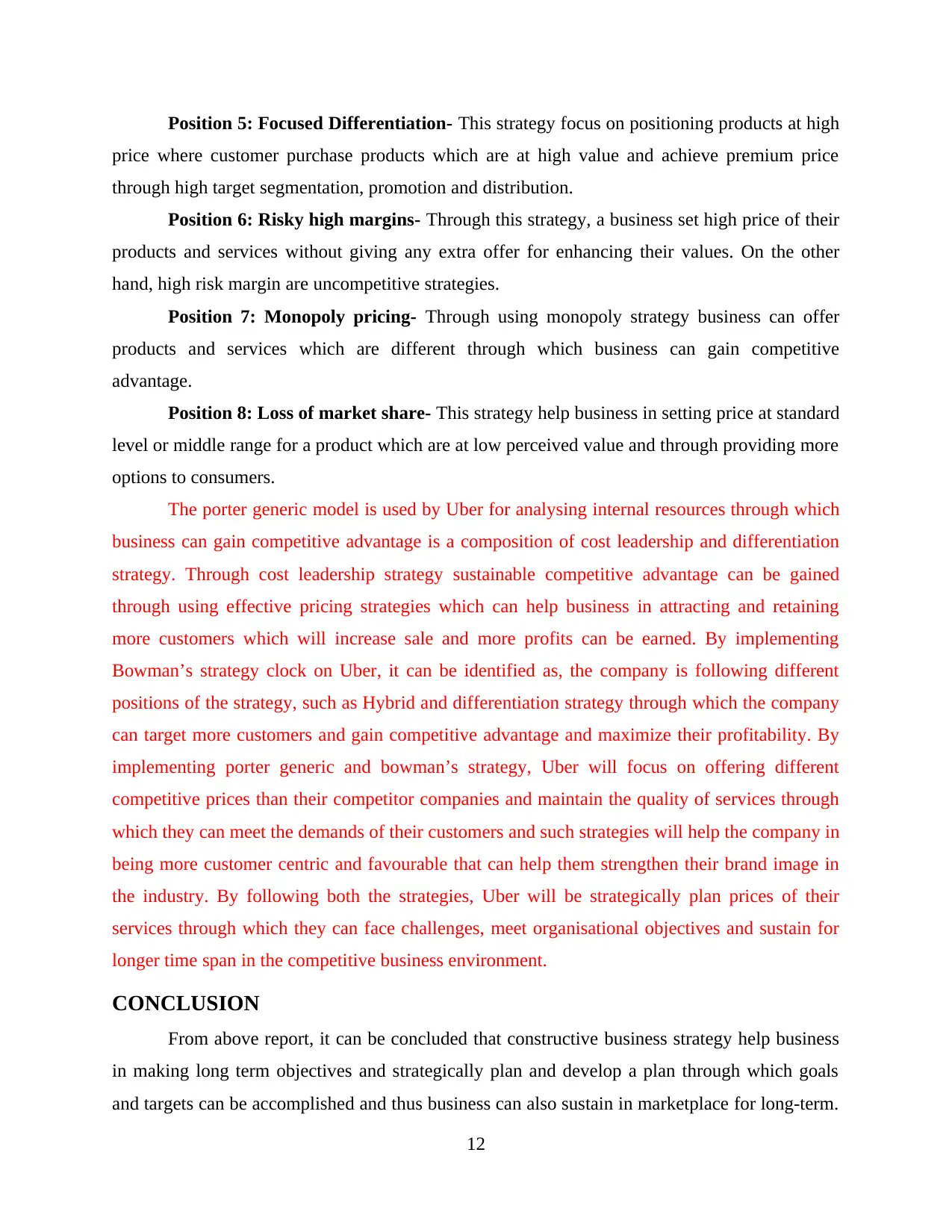
Position 5: Focused Differentiation- This strategy focus on positioning products at high
price where customer purchase products which are at high value and achieve premium price
through high target segmentation, promotion and distribution.
Position 6: Risky high margins- Through this strategy, a business set high price of their
products and services without giving any extra offer for enhancing their values. On the other
hand, high risk margin are uncompetitive strategies.
Position 7: Monopoly pricing- Through using monopoly strategy business can offer
products and services which are different through which business can gain competitive
advantage.
Position 8: Loss of market share- This strategy help business in setting price at standard
level or middle range for a product which are at low perceived value and through providing more
options to consumers.
The porter generic model is used by Uber for analysing internal resources through which
business can gain competitive advantage is a composition of cost leadership and differentiation
strategy. Through cost leadership strategy sustainable competitive advantage can be gained
through using effective pricing strategies which can help business in attracting and retaining
more customers which will increase sale and more profits can be earned. By implementing
Bowman’s strategy clock on Uber, it can be identified as, the company is following different
positions of the strategy, such as Hybrid and differentiation strategy through which the company
can target more customers and gain competitive advantage and maximize their profitability. By
implementing porter generic and bowman’s strategy, Uber will focus on offering different
competitive prices than their competitor companies and maintain the quality of services through
which they can meet the demands of their customers and such strategies will help the company in
being more customer centric and favourable that can help them strengthen their brand image in
the industry. By following both the strategies, Uber will be strategically plan prices of their
services through which they can face challenges, meet organisational objectives and sustain for
longer time span in the competitive business environment.
CONCLUSION
From above report, it can be concluded that constructive business strategy help business
in making long term objectives and strategically plan and develop a plan through which goals
and targets can be accomplished and thus business can also sustain in marketplace for long-term.
12
price where customer purchase products which are at high value and achieve premium price
through high target segmentation, promotion and distribution.
Position 6: Risky high margins- Through this strategy, a business set high price of their
products and services without giving any extra offer for enhancing their values. On the other
hand, high risk margin are uncompetitive strategies.
Position 7: Monopoly pricing- Through using monopoly strategy business can offer
products and services which are different through which business can gain competitive
advantage.
Position 8: Loss of market share- This strategy help business in setting price at standard
level or middle range for a product which are at low perceived value and through providing more
options to consumers.
The porter generic model is used by Uber for analysing internal resources through which
business can gain competitive advantage is a composition of cost leadership and differentiation
strategy. Through cost leadership strategy sustainable competitive advantage can be gained
through using effective pricing strategies which can help business in attracting and retaining
more customers which will increase sale and more profits can be earned. By implementing
Bowman’s strategy clock on Uber, it can be identified as, the company is following different
positions of the strategy, such as Hybrid and differentiation strategy through which the company
can target more customers and gain competitive advantage and maximize their profitability. By
implementing porter generic and bowman’s strategy, Uber will focus on offering different
competitive prices than their competitor companies and maintain the quality of services through
which they can meet the demands of their customers and such strategies will help the company in
being more customer centric and favourable that can help them strengthen their brand image in
the industry. By following both the strategies, Uber will be strategically plan prices of their
services through which they can face challenges, meet organisational objectives and sustain for
longer time span in the competitive business environment.
CONCLUSION
From above report, it can be concluded that constructive business strategy help business
in making long term objectives and strategically plan and develop a plan through which goals
and targets can be accomplished and thus business can also sustain in marketplace for long-term.
12
⊘ This is a preview!⊘
Do you want full access?
Subscribe today to unlock all pages.

Trusted by 1+ million students worldwide
1 out of 15
Related Documents
Your All-in-One AI-Powered Toolkit for Academic Success.
+13062052269
info@desklib.com
Available 24*7 on WhatsApp / Email
![[object Object]](/_next/static/media/star-bottom.7253800d.svg)
Unlock your academic potential
Copyright © 2020–2025 A2Z Services. All Rights Reserved. Developed and managed by ZUCOL.





